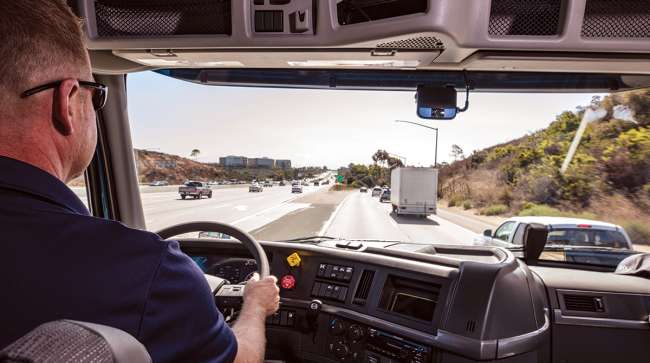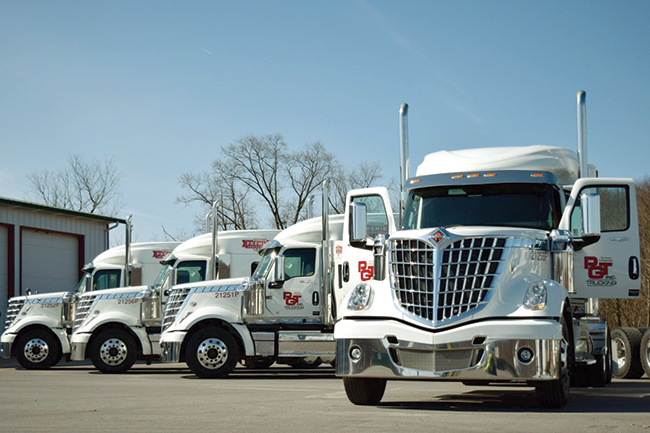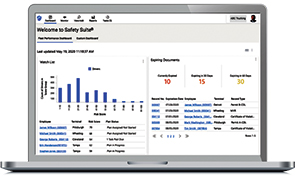Special to Transport Topics
Fleets Use Risk Management Strategies That Emphasize Training, Technology

[Stay on top of transportation news: Get TTNews in your inbox.]
Professional drivers face a multitude of potential risks every minute their trucks are out on the road. In an era of nuclear verdicts, fleets are finding it essential to maintain an effective risk management strategy to help protect the safety of their employees and the motoring public while also shielding their businesses from liability.
The purpose of a risk management strategy is to manage — and mitigate — potential risks. This includes anticipating the possibility of at-fault driver incidences, engaging in prevention and reducing claims against the carrier.
Although there are numerous other risks in the transportation industry, driver performance is a large component.

Drivers, for instance at PGT Trucking, have to meet risk management guidelines set forth by both the DOT as well as the company’s own requirements. (PGT Trucking)
Having a well-developed risk management strategy makes good business sense, said Adam Lang, chief risk officer at Halvor Lines, a trucking and logistics company based in Superior, Wis.
“Without a risk management program, when an event happens, you have no guidelines of what you asked the driver to do or not to do. Having a risk management program sets the baseline of expectations,” he said.
Lang added that risk management is more necessary than ever because of the increase in nuclear verdicts. Trucking companies need to make sure that safety data is accessible and good records are kept, ensuring that drivers are being properly vetted and coached.
Overall, he noted, risk management policies should be transparent and include stringent procedures and guidelines for driver hiring, coaching and discipline, as well as accident reporting, comprehensive investigations and data analysis pertaining to any road incidents. Lang recommended that all drivers and management should also be held accountable for adherence to safety protocols. Policies should be re-evaluated regularly and communicated to all parties.
When bringing new drivers aboard, Halvor adheres to strict hiring criteria, including reference checks, drug and alcohol checks, and accident and safety history to start.
“We also require drivers to do a very large amount of pre-employment training,” Lang added. “They need to check a lot of boxes before showing up to orientation.”

A driver checks his tires during a pretrip inspection. Industry insiders say that risk management policies should be transparent and include guidelines for driver hiring, coaching and discipline.
(1933bk via Getty Images)
At PGT Trucking in Aliquippa, Pa., drivers have to meet guidelines set forth by both the U.S. Department of Transportation and the company’s own requirements. The company’s president, Gregg Troian, said the best risk management advice is to hire the right driver in the first place, which he said comes from experience.
PGT Trucking uses various in-house tests to help make those hiring decisions, but unfortunately, the pool of available drivers has dwindled over the years.
“Every trucking company right now is seeking drivers,” Troian said.
Preventing risky driver behavior in the first place is the ideal, he added. Troian recommended a coaching program to mitigate risk and hire coachable drivers.
“We try to work with drivers that want to be worked with,” he said. “There are drivers who make good students, no matter how long they’ve been driving a truck. Then we have drivers who don’t believe they need any coaching, and we have to make our decisions based on who is coachable and who isn’t.”
PGT ranks No. 98 on the Transport Topics Top 100 list of the largest for-hire carriers in North America.
In the transportation industry, there is a strong movement toward digitization of risk management. Many carriers utilize comprehensive driver management platforms that provide real-time information about driver performance; the data can then be interpreted to engage in driver coaching.
“The best risk program is preventing accidents from happening in the first place,” said Hayden Cardiff, CEO of Idelic, a developer of driver management software that ties in risk, safety, compliance, operations, retention and training.
Idelic’s Safety Suite uses artificial intelligence to “understand driver behavior to assign risk proactively and predictively, giving fleets understanding of why that driver is at risk, how much each event contributes to risk scores and allows them to assign corrective action and coaching over subsequent weeks,” Cardiff said.

Idelic’s Safety Suite uses artificial intelligence to understand driver behavior to assign driver risk proactively. (Idelic)
Technology firm Netradyne offers a fleet safety platform called Driveri, which utilizes onboard cameras and artificial intelligence to monitor objects on the road and analyze how well the driver handles those risks.
The advantage of such real-time systems is that safety managers can address issues as they happen, said Adam Kahn, president of Netradyne’s commercial fleet team. For example, Kahn noted, a driver caught on his mobile phone may receive some coaching in the form of an audio message to him.
Driveri also analyzes both positive and negative driver behaviors.
“If you’re going to coach your workforce, we take the stance of maybe you don’t always point the finger, but you can give them a thumbs-up. That is a really powerful thing,” Kahn said. “It is hard to replace drivers. The goal shouldn’t be how do I get my worst drivers out, but how to get my fleet to act like my best drivers.”
PGT’s Troian said this type of technology has “allowed us to be more aware of drivers we have to monitor more closely.”
It has also enabled his company to engage in better, more targeted coaching.
“On the whole, driver performance has improved,” Troian said.
Halvor Lines has noticed a correlation between the company’s use of a driver management platform and a decrease in accidents.
Lang cited a decrease in unsafe driving behavior and a 10-point drop in unsafe driving violations.
“We’ve seen a decrease in DOT recordable collisions,” he said. “We’ve seen a decrease in rear-end collisions, though part of that is implementing more collision mitigation [technology] in our trucks.”
Lang observed that in the event of an accident, having real-time safety monitoring “helps change the approach with how you deal with the other party.”
He said it’s one thing to take gambles in life, but in business, particularly in the trucking industry when human lives are at stake, mitigating risk is the prudent path.
“It’s financially more beneficial to be proactive with your risk management. If you wait for things to happen, they will. It is especially true in transportation. The more proactive things you can do to cut off problems before they occur, the more that they will impact the bottom line,” Lang said. “By having a camera system, you can settle and take care of claims more quickly, be more proactive with risky driver behavior and minimize the possibility of a claim.”
Netradyne’s Kahn recommended that companies set clear standards for driver performance.
“The better fleets are very articulate about the expectations they have for the drivers,” he added. “If the drivers fall outside the expectations, a good risk management system will have a smooth way of bringing drivers back inside the lines.”
Want more news? Listen to today's daily briefing below or go here for more info:


